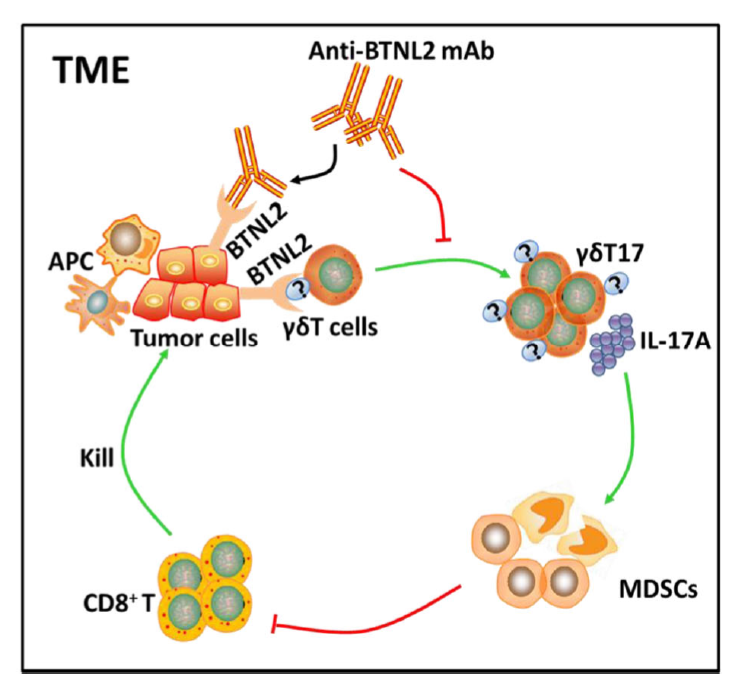The team of Professor Chenhui Wang from the School of Life Science and Technology of Huazhong University of Science and Technology published the title "Cancer cell-expressed BTNL2 facilitates tumor immune escape via engagement with IL-17A producing γδ T cells" in the international authoritative journal "Nature Communications" latest research results.

In recent years, tumor immunotherapy has made rapid progress. Among them, immune checkpoint inhibitors (mainly including CTLA-4 and PD-1/PD-L1 immune checkpoint inhibitor drugs) that are at the forefront of tumor immunotherapy have shown good curative effects on multiple cancer types. Although CTLA-4 and PD-1/PD-L1 immune checkpoint inhibitor drugs have achieved obviously therapeutic effect for cancer treatment in clinical applications, many cancer patients aren’t benefit from current available immune checkpoint inhibitor drugs because of the disappointingly low overall response rate (about 10-30%). These evidences suggest that there may be other immune checkpoint molecules or mechanisms that contribute to dysfunctional antitumor immunity in the tumor microenvironment (TME). Therefore, finding new immune checkpoints and developing blocking antibodies against these new targets will be an effective way to improve the response rate for cancer patients.
Butyrophilin-like protein 2 (BTNL2) is a transmembrane immunoregulatory protein that is highly expressed in the gastrointestinal tract and belongs to the butyrophilin-like family of proteins. Previous study reported that BTNL2-Fc fusion protein directly inhibited CD4+ T cell activation in vitro, Intriguingly, it has also been reported that polymorphic variants of BTNL2 are associated with susceptibility to several autoimmune diseases and cancer, including lung and prostate adenocarcinoma. One recent clinical study found that the expression of BTNL2 and other immune checkpoint molecules, including CTLA-4, was increased following anti-PD-1 therapy, further suggesting that BTNL2 may represent a novel mechanism of cancer immune evasion.
Through research, we found that BTNL2 inhibits antitumour immunity by acting on the γδ T cell population in the tumor microenvironment to promote IL-17A production which enhances tumour immune resistance via recruitment of MDSCs,then reduction of cytotoxic CD8+ T cell infiltration. Blockage of BTNL2 with a novel monoclonal neutralizing antibody has a significant therapeutic effect for multiple mice tumours, and has a synergistic effect with anti-PD-1 blockage. Our further study found that BTNL2 expression in human tumors was highly correlated with patient prognosis as well as γδT17 infiltration. Patients with lung adenocarcinoma and colon adenocarcinoma that expressed low levels of BTNL2 had significantly improved survival compared to those expressing high levels of BTNL2. In lung adenocarcinoma samples, BTNL2 was mainly expressed by cancer cells. Importantly, protein levels of BTNL2 were much higher in almost all of the examined cancer samples when compared to matched para-cancerous tissue. BTNL2 is not only an attractive target candidate for cancer immunotherapy but also may have utility as a biomarker for lung adenocarcinoma. In summary, we report that BTNL2 is a promising cancer immunotherapeutic target, with potential to enhance the efficacy of currently available immunotherapies, and possibly also to offer alternative standalone therapy in patients who are resistant to the current cancer immunotherapy.
There are still some important scientific questions which need to be further studied: 1) What molecule is the receptor of BTNL2 on the surface of T cells? 2) Our study and many other studies have found that BTNL2 can directly inhibit the activation of CD4+ T cells and CD8+ T cells. What is the mechanism of its inhibition for T cell activation? Does this mechanism also play a role in antitumor immune escape? 3) The mouse subcutaneous tumor model was mostly used in this study. Does BTNL2 also play a role in spontaneous tumor or drug-induced tumor models? Is the mechanism by which it works different? 4) The single nucleotide polymorphisms or expression changes of BTNL2 are associated with the susceptibility of prostate cancer, melanoma, breast cancer and other cancers. Does BTNL2 also play an anti-tumor immune escape role in many other cancers?
Ph.D. student Yanyun Du and Ph.D. student Qianwen Peng from the School of Life Sciences of Huazhong University of Science and Technology are the co-first authors of the paper. Huazhong University of Science and Technology is the first affiliation of the paper. Professor Chenhui Wang from the School of Life Science and Technology, Huazhong University of Science and Technology is the corresponding author. This research was supported by the National Natural Science Foundation of China, the National Key R&D Program and other funds.

Link:https://doi.org/10.1038/s41467-021-27936-8